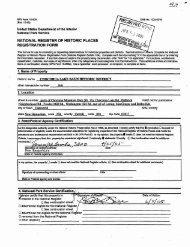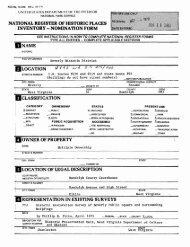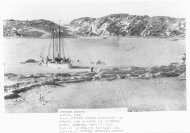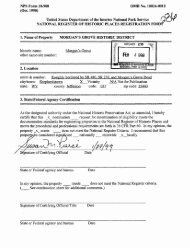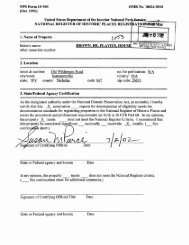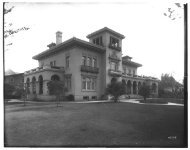National Register of Historic Places Registration Form
National Register of Historic Places Registration Form
National Register of Historic Places Registration Form
You also want an ePaper? Increase the reach of your titles
YUMPU automatically turns print PDFs into web optimized ePapers that Google loves.
NPS <strong>Form</strong> 10-900-a OMB Approval No. 1024-0018<br />
(M6)<br />
United States Department <strong>of</strong> the Interior<br />
<strong>National</strong> Park Service<br />
<strong>National</strong> <strong>Register</strong> <strong>of</strong> <strong>Historic</strong> <strong>Places</strong><br />
Continuation Sheet<br />
CLEVELAND PARK HISTORIC DISTRICT<br />
WASHINGTON D.C.<br />
Section number 8 Page _J__<br />
The Neighborhood commercial precinct in the Cleveland Park <strong>Historic</strong><br />
District on Connecticut Avenue between Macomb and Porter Streets, N. W. has<br />
been determined to be significant: for the following reasons.<br />
It exemplifies the significant planning movement in the <strong>National</strong> Capital<br />
to create small-scale commercial centers designed to service their immediate<br />
residential neighborhoods.<br />
It represents the designation <strong>of</strong> commercial "islands" along Connecticut<br />
Avenue (<strong>of</strong> which Cleveland Park's commercial precinct is one) in the<br />
District's original (1920) Zoning Ordinance which was a highly unusual<br />
initiative at that time and reflects the most advanced concepts <strong>of</strong> city<br />
planning for residential areas -- it may well be <strong>of</strong> national significance.<br />
Preliminary evidence suggests this provision for commercial development<br />
along Connecticut Avenue subsequently influenced zoning and the nature <strong>of</strong><br />
commercial development in other parts <strong>of</strong> the city and in nearby suburban<br />
communities.<br />
It exemplifies a significant aspect <strong>of</strong> the economic/historical heritage<br />
<strong>of</strong> the <strong>National</strong> Capital in providing a full range <strong>of</strong> retail services to a<br />
residential area; it was among che most fully developed <strong>of</strong> its type in the<br />
city prior to WWII.<br />
The Park and Shop complex established a model for planned neighborhood<br />
shopping centers in the region, with a coordinated ensemble <strong>of</strong> stores, the<br />
presence <strong>of</strong> each calculated to reinforce the attraction <strong>of</strong> others.<br />
As a whole, the precinct represents probably the finest architectural<br />
grouping <strong>of</strong> neighborhood commercial buildings in the <strong>National</strong> Capital and from<br />
a national perspective, the grouping is an excellent example <strong>of</strong> period/type.<br />
The commercial precinct includes outstanding individual works <strong>of</strong><br />
architecture:<br />
The Park and Shop complex (1930) a nationally significant work in the<br />
evolution <strong>of</strong> the shopping center which was widely publicized and praised<br />
during the 1930's, a prototype for a number <strong>of</strong> other complexes in the<br />
metropolitan area and elsewhere in the U.S. during the 1930's and 1940's is<br />
among the most architecturally significant commercial properties in the<br />
<strong>National</strong> Capital.<br />
The Uptown Theatre (1936) is among the largest and finest neighborhood<br />
movie houses built in the city and is an outstanding example <strong>of</strong> Art Deco<br />
commercial architecture in the city and region and perhaps the finest 20th<br />
century building <strong>of</strong> its type to survive in the metropolitan area.<br />
The Fire Station #28 (1916) is an important example in the city <strong>of</strong><br />
Colonial Revival design used for a small-scale public building and is a<br />
significant early example in the city <strong>of</strong> a firehouse designed exclusively for<br />
motorized vehicles. It is a splendid representative <strong>of</strong> City Beautiful efforts<br />
to employ high standards <strong>of</strong> public building design in neighborhoods and it is<br />
among the finest example <strong>of</strong> its type remaining in the metropolitan area.<br />
The Macklin apartments/stores (1939) is an ingenious mixed-use complex<br />
with an unusually sensitive configuration designed in response to its urban<br />
context and is a good example <strong>of</strong> Art Deco design.<br />
Thomas E. Clark*s Showroom (3407 Conn. Ave. ^ now McDonald's Restaurant)<br />
(1930) is an excellent example <strong>of</strong> Art Deco storefront design in the city and a



